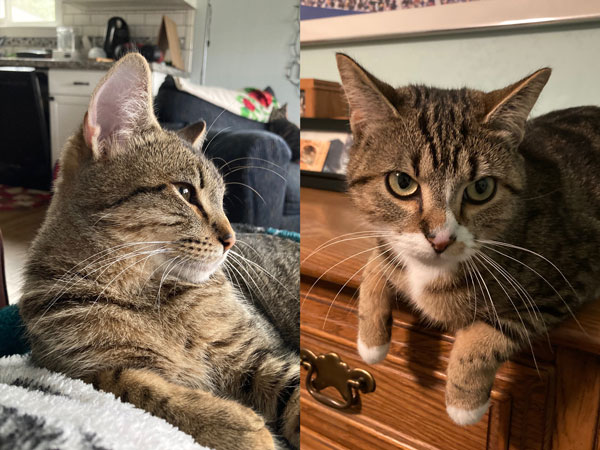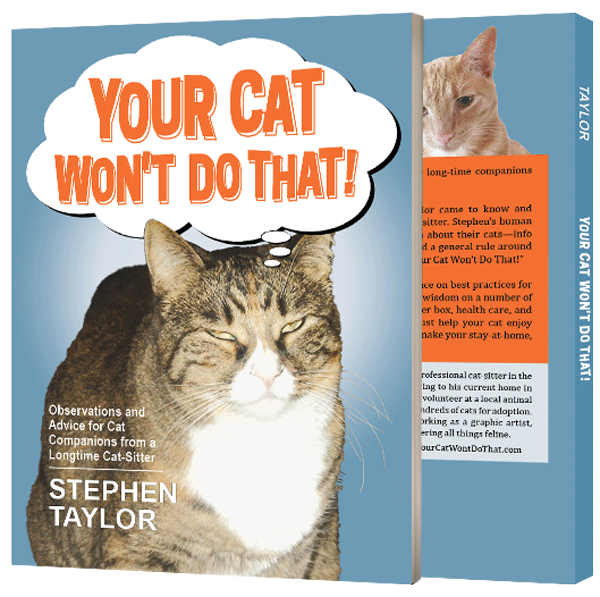

Niblet and Cookie have affirmed much of my cat adoption advice from Your Cat Won't Do That!--and even expanded upon it--since joining my household.
In chapter 6 of Your Cat Won’t Do That!, “Adding to Your Clowder,” I offered some observations about what you should consider before you adopt a cat…or another cat, as the case may be. Since the book was published, I have myself adopted two cats, one-year-old littermates named Cookie and Niblet, and in the wake of these additions to my own clowder, I’d like to take a few minutes to review and expand a bit further on what I wrote in YCWDT!
Chief among my observations was to note that one should carefully consider a cat’s age, and your own nature, before making an adoption. Specifically, I advised against reflexively bringing home a kitten (or two). My rationale for that view was simple: kittens may be fun and cute, but they can also be a handful. Their activity level is usually so high that, for anyone who values the chance to relax once in a while, kittens can be draining. Per my advice, those who prefer a more sedate lifestyle should consider an adult cat for your next housemate.
(Just to be clear, let’s define what I mean by kitten and adult cat. At the shelter where I volunteered, any cats under 6 months old were considered kittens. Any cat 6 months or older was labeled an adult--though obviously, there’s a difference between a one- or two-year-old cat and one that has reached the ripe old age of 10 or beyond.)
So, now that I have two one-year-old cats in my home, it’s a good time to ask the pertinent question: Was I wrong about “the kitten issue?”
No! The only thing I got wrong, perhaps, was that I was a bit too narrow in limiting the advice to kittens.
As I have learned through my own experience with Niblet and Cookie, my caution about adopting kittens should apply to young adult cats, too. Indeed, cats in their first and second years of life can be just as energetic, playful, and demanding of their human companion as any kitten.
Not only are young adults as prone to high-energy play, major mischief-making, and sometimes outright “crime sprees” as kittens, but--since they are fully grown--one-year-olds have the “muscle” to back up their rambunctiousness. Fully-grown but still young cats can make a major impact whenever they play a bit too robustly: when they start knocking over housewares (or even furniture!), when they tear up anything and everything they encounter, or simply whenever they get “the crazies” at an inconvenient hour. The difference between sharing a house with young, rambunctious cats versus sharing one with a couple of stately, dignified old mousers can be the difference between living in a home and living in Thunderdome.

Now, as I noted in YCWDT!, this difference and its acceptability in your own life is largely a matter of your preferences. Individual circumstances and temperament will make the difference between a house of feline chaos being a barrel of fun…or a steady, shrieking run to the madhouse.
A home with young children might barely notice much in the way of kitten-inspired chaos going on, whereas a single person living alone--I raise my hand to that description--dealing with two boisterous young cats can make you feel outnumbered and overwhelmed.
Another factor at work in this equation, on the human side, is not just your temperament, but your age as well. Younger people will get along better with younger cats, because they typically can match energy with energy; twenty-year-olds are unlikely to get easily exhausted when dealing with frenzied felines.
On the other hand, those in middle age will have a tougher time keeping up with their rowdy cat companions. It’s also worth noting that, for older people, one of the key threats to staying healthy and in one piece is simply falling down--and that’s a fate that becomes much more difficult to avoid when you have a crazy cat running past your feet, and around your feet--and sometimes even between your feet--as you move from room to room. In just over a month of living with my new inmates, I have had each of my cats nearly knock me over from running through the house and around my legs. You love your cats, for sure, but that doesn’t mean you will be cool with breaking your hip because of them! For older people, older, slower-moving cats can minimize such risks.
So, one conclusion is simple: when adopting cats, match age for age. Younger cats belong with younger people; older people should get older cats.
As I said, I adopted not just one cat but two. I followed my own YCWDT! advice and made sure to get a pair of already-bonded cats to come into the house together, to avoid any situation where my cats would not get along. (I was adopting into an empty house, as my Maxi--the YCWDT! cover model--passed away two years ago.)
This advice too has proved valid in practice, as Cookie and Niblet (who are sister and brother) mostly get along very well. There are occasional squabbles, as you'll get with any two cats who share living space. Every once in a while there's even a real knockdown, drag-out wrestling match--but nothing truly dangerous. Mostly, they get along well, and they keep each other company when I am working in my home office or otherwise not available for play--and they still have a good sense of when to leave each other alone and have time to themselves, too.
I can’t stress it enough: when you’re searching for cats to adopt, especially if you are looking for two or more, be absolutely certain to read the available information offered by the shelter and find cats that are already bonded and compatible with each other. It’s like skipping to the head of the line when it comes to making sure your new cats add to a harmonious home.
Finally, there is one aspect of cat adoption that I did not cover--or, really, even consider--in YCWDT!: cost.
As I write these words, in mid-2022, inflation is a major concern and the cost of living is going up all over. Pet costs are just as vulnerable to higher prices as anything else. So while adopting a cat or two may bring you a wealth of joy and loving, it will certainly cost you financially--and probably more than you think it will.
Be very aware, before you adopt, that whatever amount of money you’re budgeting each month for the feeding and care of your new cats, that number will probably be too low to match the reality.
If you adopt youngsters, you can probably save some money by putting off buying pet insurance. In my experience, cats that make it past kittenhood healthy tend to stay that way, at least for a few years. And, of course, as noted in chapter 5 of YCWDT!, indoor cats generally remain healthier than those who are let out into the wide world. If you adopt a senior cat, then I would certainly recommend you bite the bullet and get some kind of insurance for your cat’s health. It may be initially expensive, but if a serious illness arises--and that’s likely with a cat over 10 years old--the insurance can pay for itself pretty quickly.
In sum: be sure going in that you can afford the costs involved in taking care of your new friends; the last thing you want to have happen is to adopt a cat, or two (or more?!) and then have to return them to the shelter because they are just too expensive for your means.
It may be tempting to just go out and, on the spur of the moment, find an adoptable cat and bring it home with you--but I strongly recommend you give the considerations listed above plenty of thought before you make that move and bring a new kitty home. If you’re prepared for all the obstacles and hurdles beforehand, the chances are that much greater that you and your new cat--or cats!--will have many happy years together.
Thanks for checking in on this bonus chapter of Your Cat Won’t Do That! Don't forget to read bonus chapters #1 and #2. For further insights on cat-sitting, cat care and cat adoption, please read the full volume of YCWDT!, available now in print and in e-formats.
Disclaimer: please note that the views expressed in this essay are strictly the author’s opinions. They should be considered critically, and all decisions you make about your cat and his/her health, comfort and safety should be made as fully-informed judgments.
Thank you for visiting this page, and for your interest in Your Cat Won't Do That!